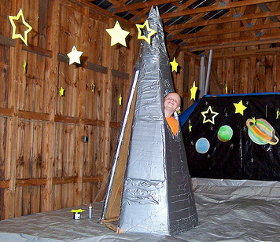 Elementary school children need to know that the earth goes around the sun, and that the moon goes around the earth. But how this works can be hard to understand.
Elementary school children need to know that the earth goes around the sun, and that the moon goes around the earth. But how this works can be hard to understand.
Make it easier by having the children themselves play the parts of the earth, sun, and moon and move through their motions. It’s a super-fun movement activity that will improve their physical fitness and coordination at the same time that they learn the astronomy.
Help the children take this concept further with a class discussion, and then reinforce it with a drawing project.
Observation
To begin with, ask the students to figure out what they already know, and how they know it. If they can, have them go outside and look at the sun. Where does it rise? Where does it set? Why does the sun rise and set? When do they see the moon? Why do they sometimes see the moon in the daytime?
Write down what they already know on a board or a big poster or projection.
Some Basic Facts
Explain that the earth goes around the sun, and the moon goes around the earth. It takes a year for the earth to go around the sun, and the earth spins all the away around once every day. It takes about a month for the moon to go around the earth, but the moon always has the same side towards the earth.
The Earth Dance
Ask the students to get into groups of three. One child will be the sun and stand still in one spot. The second child will be the earth and walk slowly around the sun in a small circle, spinning around as he goes, once for each day. The third child will be the moon and circle around the earth while the earth is moving, but always facing towards the earth.
Have the earth start first to get the hang of it before the moon tries to join in. It’s pretty hard to do this, but it does make sure everyone has the idea. Have the students switch roles if there is time.
Discussion
What other questions do the children have after doing this activity? How far away is the sun? What about the other planets? Do they also go around the sun? Do they also have moons? Does it take more or less time for Jupiter to go around the sun than the earth does?
Be prepared to answer some questions, and to help the children look up answers to others.
Art
As a follow-up activity, have the students draw diagrams in crayon or pastel on black construction paper of the relationship among the earth, the sun, and the moon.
Do you have any other ideas for teaching the rotation of the earth and the sun?
About The Author
Professor Carr is the publisher of Kidipede, an online encyclopedia of history and science at http://www.historyforkids.org. Kidipede, online since 1996, is a favorite educational resource for students, teachers, and parents.

I need something for my 8th grade class.